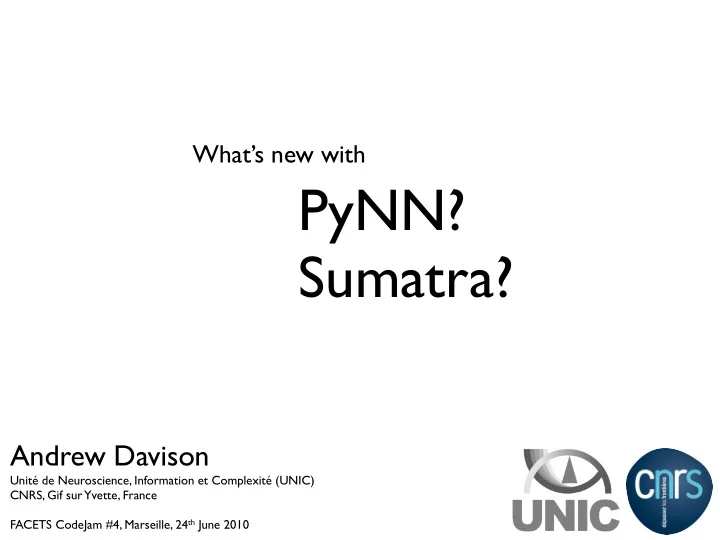

What’s new with PyNN? Sumatra? Andrew Davison Unité de Neuroscience, Information et Complexité (UNIC) CNRS, Gif sur Yvette, France FACETS CodeJam #4, Marseille, 24 th June 2010
What the **** is PyNN? Sumatra?
Simulator diversity: problem and opportunity Cons • Considerable di ffj culty in translating models from one simulator to another... • ...or even in understanding someone else’s code. • This: - impedes communication between investigators, - makes it harder to reproduce other people’s work, - makes it harder to build on other people’s work. Pros • Each simulator has a di fg erent balance between e ffj ciency, flexibility, scalability and user-friendliness → can choose the most appropriate for a given problem. • Any given simulator is likely to have bugs and hidden assumptions, which will be revealed by cross-checking results between di fg erent simulators → greater confidence in correctness of results.
a common API for spiking network simulators • Goal: write the code for a simulation Cawan Cake by Nono Fara http://www.flickr.com/photos/n-o-n-o/3280580620/ once, run it on any supported simulator or hardware device without modification . ✦ keep the advantages of having multiple simulators or hardware devices ✦ but remove the translation barrier*.
a common API for spiking network simulators • Goal: write the code for a simulation Cawan Cake by Nono Fara http://www.flickr.com/photos/n-o-n-o/3280580620/ once, run it on any supported simulator or hardware device without modification . ✦ keep the advantages of having *aka: having multiple simulators or hardware your cake devices and eating it ✦ but remove the translation barrier*.
PyNN Simulator-specific pynn. pynn. pynn.nest pynn.pcsim pynn.neuron pynn.brian pynn.neuroml pynn.moose facetshardware1 genesis2 PyNN module nrnpy PyNEST Python interpreter PyPCSIM PyHAL PyMOOSE Brian Native interpreter SLI hoc NeuroML sli FACETS NEST PCSIM NEURON GENESIS 2 MOOSE Simulator kernel hardware Direct communication Code generation Implemented Planned
sim.setup(timestep=0.1) cell_parameters = {”tau_m”: 12.0, ”cm”: 0.8, ”v_thresh”: -50.0, ”v_reset”: -65.0} pE = sim.Population((100,100), sim.IF_cond_exp, cell_parameters, label=”excitatory neurons”) pI = sim.Population((50,50), sim.IF_cond_exp, cell_parameters, label=”inhibitory neurons”) input = sim.Population(100, sim.SpikeSourcePoisson) rate_distr = random.RandomDistribution(”normal”, (10.0, 2.0)) input.rset(”rate”, rate_distr) background = sim.NoisyCurrentSource(mean=0.1, stdev=0.01) pE.inject(background) pI.inject(background) DDPC = sim.DistanceDependentProbabilityConnector weight_distr = random.RandomDistribution(”uniform”, (0.0, 0.1)) connector = DDPC(”exp(-d**2/400.0)”, weights=weight_distr, delays=”0.5+0.01d”) TMM = sim. TsodyksMarkramMechanism depressing = sim.DynamicSynapse(fast=TMM(U=0.5,tau_rec=800.0)) e2e = sim.Projection(pE, pE, connector, target=”excitatory”, synapse_dynamics=plasticity) e2i = sim.Projection(pE, pI, connector, target=”excitatory”) i2e = sim.Projection(pI, pE, connector, target=”inhibitory”)
import pyNN.neuron as sim sim.setup(timestep=0.1) cell_parameters = {”tau_m”: 12.0, ”cm”: 0.8, ”v_thresh”: -50.0, ”v_reset”: -65.0} pE = sim.Population((100,100), sim.IF_cond_exp, cell_parameters, label=”excitatory neurons”) pI = sim.Population((50,50), sim.IF_cond_exp, cell_parameters, label=”inhibitory neurons”) input = sim.Population(100, sim.SpikeSourcePoisson) rate_distr = random.RandomDistribution(”normal”, (10.0, 2.0)) input.rset(”rate”, rate_distr) background = sim.NoisyCurrentSource(mean=0.1, stdev=0.01) pE.inject(background) pI.inject(background) DDPC = sim.DistanceDependentProbabilityConnector weight_distr = random.RandomDistribution(”uniform”, (0.0, 0.1)) connector = DDPC(”exp(-d**2/400.0)”, weights=weight_distr, delays=”0.5+0.01d”) TMM = sim. TsodyksMarkramMechanism depressing = sim.DynamicSynapse(fast=TMM(U=0.5,tau_rec=800.0)) e2e = sim.Projection(pE, pE, connector, target=”excitatory”, synapse_dynamics=plasticity) e2i = sim.Projection(pE, pI, connector, target=”excitatory”) i2e = sim.Projection(pI, pE, connector, target=”inhibitory”)
import pyNN.nest as sim sim.setup(timestep=0.1) cell_parameters = {”tau_m”: 12.0, ”cm”: 0.8, ”v_thresh”: -50.0, ”v_reset”: -65.0} pE = sim.Population((100,100), sim.IF_cond_exp, cell_parameters, label=”excitatory neurons”) pI = sim.Population((50,50), sim.IF_cond_exp, cell_parameters, label=”inhibitory neurons”) input = sim.Population(100, sim.SpikeSourcePoisson) rate_distr = random.RandomDistribution(”normal”, (10.0, 2.0)) input.rset(”rate”, rate_distr) background = sim.NoisyCurrentSource(mean=0.1, stdev=0.01) pE.inject(background) pI.inject(background) DDPC = sim.DistanceDependentProbabilityConnector weight_distr = random.RandomDistribution(”uniform”, (0.0, 0.1)) connector = DDPC(”exp(-d**2/400.0)”, weights=weight_distr, delays=”0.5+0.01d”) TMM = sim. TsodyksMarkramMechanism depressing = sim.DynamicSynapse(fast=TMM(U=0.5,tau_rec=800.0)) e2e = sim.Projection(pE, pE, connector, target=”excitatory”, synapse_dynamics=plasticity) e2i = sim.Projection(pE, pI, connector, target=”excitatory”) i2e = sim.Projection(pI, pE, connector, target=”inhibitory”)
import pyNN.hardware.facets.stage1 as sim sim.setup(timestep=0.1) cell_parameters = {”tau_m”: 12.0, ”cm”: 0.8, ”v_thresh”: -50.0, ”v_reset”: -65.0} pE = sim.Population((100,100), sim.IF_cond_exp, cell_parameters, label=”excitatory neurons”) pI = sim.Population((50,50), sim.IF_cond_exp, cell_parameters, label=”inhibitory neurons”) input = sim.Population(100, sim.SpikeSourcePoisson) rate_distr = random.RandomDistribution(”normal”, (10.0, 2.0)) input.rset(”rate”, rate_distr) background = sim.NoisyCurrentSource(mean=0.1, stdev=0.01) pE.inject(background) pI.inject(background) DDPC = sim.DistanceDependentProbabilityConnector weight_distr = random.RandomDistribution(”uniform”, (0.0, 0.1)) connector = DDPC(”exp(-d**2/400.0)”, weights=weight_distr, delays=”0.5+0.01d”) TMM = sim. TsodyksMarkramMechanism depressing = sim.DynamicSynapse(fast=TMM(U=0.5,tau_rec=800.0)) e2e = sim.Projection(pE, pE, connector, target=”excitatory”, synapse_dynamics=plasticity) e2i = sim.Projection(pE, pI, connector, target=”excitatory”) i2e = sim.Projection(pI, pE, connector, target=”inhibitory”)
Since CodeJam #3 0.6 1. Spikes, membrane potential and synaptic conductances can now be saved to file in various binary formats. To do this, pass a PyNN File object to Population.print_X(), instead of a filename. There are various types of PyNN File object, defined in the recording.files module, e.g., StandardTextFile, PickleFile, NumpyBinaryFile, HDF5ArrayFile. 2. Added a reset() function and made the behaviour of setup() consistent across simulators. reset() sets the simulation time to zero and sets membrane potentials to their initial values, but does not change the network structure. setup() destroys any previously defined network. 3. The possibility of expressing distance-dependent weights and delays was extended to the AllToAllConnector and FixedProbabilityConnector classes. To reduce the number of arguments to the constructors, the arguments affecting the spatial topology (periodic boundary conditions, etc.) were moved to a new Space class, so that only a single Space instance need be passed to the Connector constructor. 4. Assorted speed-up s 5. Testing that results are independent of number of processors added to regression tests.
Since CodeJam #3 trunk 1. internal sub-package reorganisation in preparation for multi-compartmental models 2. connection speed-ups 3. added SmallWorldConnector 4. removed v_init as a parameter, replaced with Population.initialize() method 5. Population structure no longer restricted to a grid 6. began implementing PopulationView (sub-populations) and Assembly (collection of Populations)
http://neuralensemble.org/PyNN
Sumatra Rumah Gadang Minangkabau in West Sumatra by CharlesFred http://www.flickr.com/photos/charlesfred/2870828972/
Replicability attack of the clone santas by slowburn ♪ http://www.flickr.com/photos/36266791@N00/70150248/
but I’m getting different results” “I thought I used the same parameters attack of the clone santas by slowburn ♪ http://www.flickr.com/photos/36266791@N00/70150248/
“I thought I used the same parameters but I’m getting different results” attack of the clone santas by slowburn ♪ http://www.flickr.com/photos/36266791@N00/70150248/ “I can’t remember which version of the code I used to generate figure 6”
“I thought I used the same parameters but I’m getting different results” attack of the clone santas by slowburn ♪ http://www.flickr.com/photos/36266791@N00/70150248/ “I can’t remember which version of the code I used to generate figure 6” “The new student wants to reuse that model I published three years ago but he can’t reproduce the figures”
Recommend
More recommend